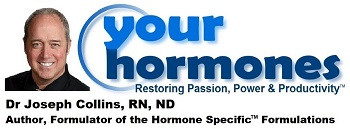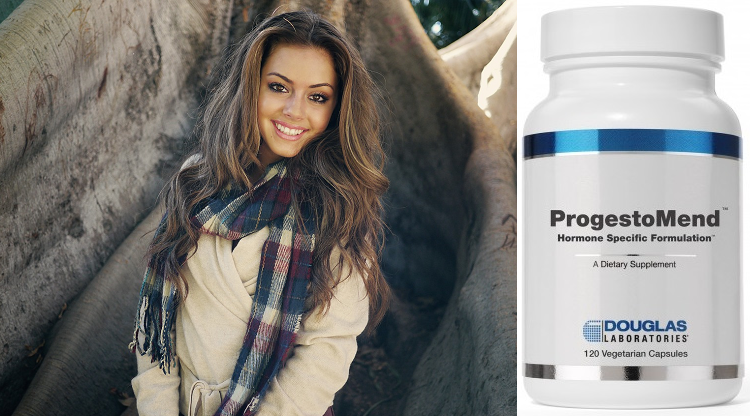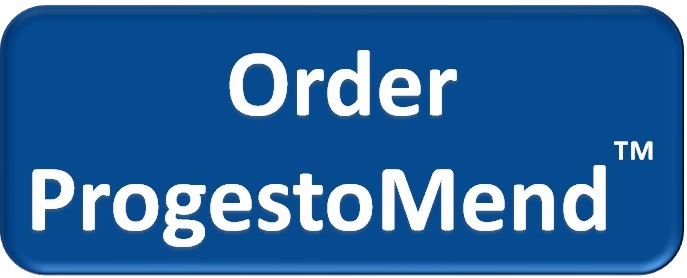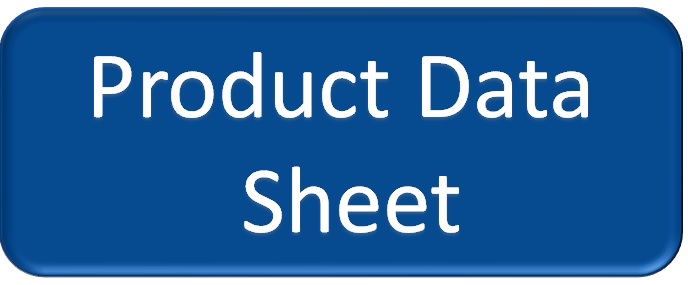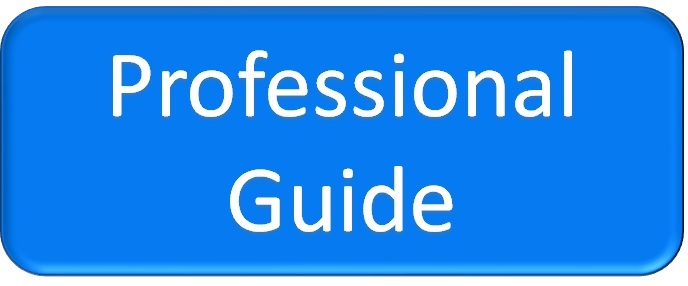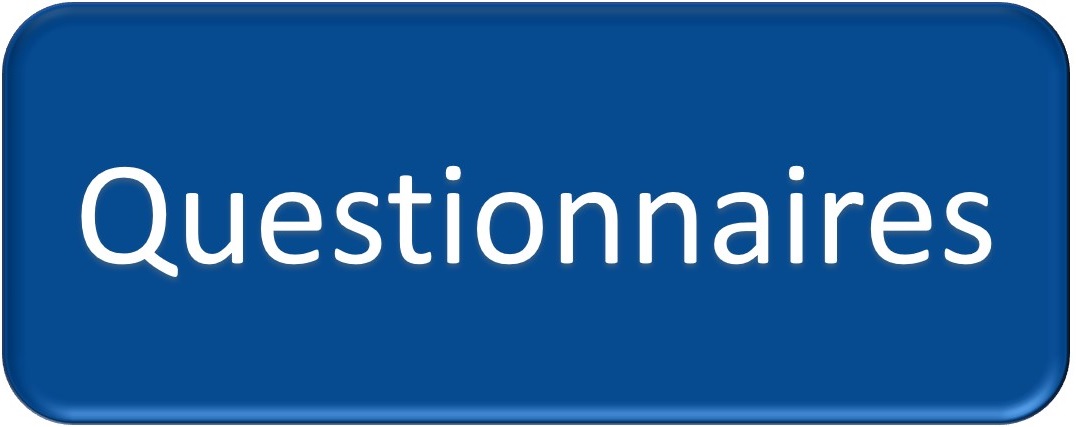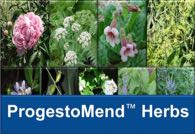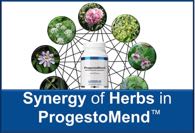The primary functions of ProgestoMend™ are to support the natural production of progesterone and supports how tissues throughout the body respond to progesterone.This is accomplished by supporting the function of progesterone producing glands, and by supporting the function of progesterone responsive tissues through the use of herbs that have phytoprogesterone properties and herbs that mimic the actions of progesterone.
Progesterone is produced in the adrenal glands of both genders, as well as by the ovaries and corpus luteum in females. While progesterone is also produced in the Leydig cells of the testes, it is typically converted to testosterone.
The synergistic combination of specific herbs in ProgestoMend™ support important functions associated with optimal progesterone health through progesterone specific actions of these herbs which:
Supports the natural production of progesterone.
Support healthy adrenal function, a major site of progesterone production.
Promote progesterone response in target tissue through the use of herbs with progesterone receptor agonist activity.
Promotes healthy function of bone, heart, brain, breasts, uterus & other progesterone sensitive tissues with progesterone mimetic herbs.
Support the anti-inflammatory, antispasmodic and anxiolytic properties of progesterone with progesterone mimetic herbs.
Supports healthy brain function, memory, and cognition, enhances mood while promoting tranquility.
How is ProgestoMend™ used?
ProgestoMend™ is used by healthcare professionals to increase the natural production of progesterone and to support the health of tissues that respond to progesterone. ProgestoMend™ improves patients with many conditions including:
Patients who do not want to use Progesterone Replacement Therapy. Some patients would prefer to restore their body’s ability to make its’ own progesterone, instead of using progesterone replacement.
Patients who have post-pill-syndrome and want to restore their body’s natural ability to make progesterone. – These patients have had their ability to make their own progesterone stopped by synthetic progestogens. ProgestoMend™ can restore endogenous progesterone production.
Progestogen induced PMS. Some PMS is brought on by synthetic progestogen suppression of natural progesterone production. ProgestoMend™ can restore endogenous progesterone production.
PMS/PMDD. Most cases of PMS/PMDD have some degree of suboptimal progesterone production and/or function. ProgestoMend™ can restore normal progesterone production and normal menstrual function.
PCOS. Low progesterone levels are almost universal in PCOS patients. ProgestoMend™ can restore optimal progesterone production. Improved progesterone function also helps control excessive androgens.
Menopause Types® 7, 8, 9, 10, 11 & 12. These Menopause Types® require restoration of progesterone by using ProgestoMend™.
Patients who have signs and symptoms of progesterone resistance. Even if lab tests show appropriate progesterone levels, some patients have progesterone receptor resistance, especially if they have a history of progestogen or prednisone use, or excessive use of progesterone.
Patients on progesterone replacement therapy who want to decrease side effects & risks associated with progesterone replacement such as weight gain and high blood sugar.
Patients who want to wean off of progesterone replacement therapy. Use ProgestoMend™ a month before weaning off of progesterone to decrease symptoms of progesterone withdrawal.
References:
Agarwal KC, Parks RE Jr. Forskolin: a potential antimetastatic agent. Int J Cancer. 1983 Dec 15;32(6):801-4.
Ben-Shlomo I, Goldman S, Shalev E. Regulation of matrix metalloproteinase-9 (MMP-9), tissue inhibitor of MMP, and progesterone secretion in luteinized granulosa cells from normally ovulating women with polycystic ovary disease. Fertil Steril. 2003 Mar;79 Suppl 1:694-701.
Bergmann J, Luft B, Boehmann S, Runnebaum B, Gerhard I. [The efficacy of the complex medication Phyto-Hypophyson L in female, hormone-related sterility. A randomized, placebo-controlled clinical double-blind study] Forsch Komplementarmed Klass Naturheilkd. 2000 Aug;7(4):190-9. German.
Cahill DJ, Fox R, Wardle PG, Harlow CR. Multiple follicular development associated with herbal medicine. Hum Reprod. 1994 Aug;9(8):1469-70.
Caprioli J, Sears M, Bausher L, Gregory D, Mead A. Forskolin lowers intraocular pressure by reducing aqueous inflow. Invest Ophthalmol Vis Sci. 1984 Mar;25(3):268-77.
Cheng JT, Tsai CL. Anti-inflammatory effect of saikogenin A. Biochem Pharmacol. 1986 Aug 1;35(15):2483-7.
Collins, JJ. 2002. Discover Your Menopause Type. Prima Publishing Rocklin, CA
Corbiere C, Liagre B, Bianchi A, Bordji K, Dauca M, Netter P, Beneytout JL. Different contribution of apoptosis to the antiproliferative effects of diosgenin and other plant steroids, hecogenin and tigogenin, on human 1547 osteosarcoma cells Int J Oncol. 2003 Apr;22(4):899-905.
Dhawan K, Kumar S, Sharma A. Anti-anxiety studies on extracts of Passiflora incarnata Linneaus. J Ethnopharmacol. 2001 Dec;78(2-3):165-70.
Dhawan K, Kumar S, Sharma A. Antiasthmatic activity of the methanol extract of leaves of Passiflora incarnata. Phytother Res. 2003 Aug;17(7):821-2.
Dhawan K. Drug/substance reversal effects of a novel tri-substituted benzoflavone moiety (BZF) isolated from Passiflora incarnata Linn.--a brief perspective. Addict Biol. 2003 Dec;8(4):379-86. Review.
Ding Z, Gao C, Ji R, Wo X. [Effects of xuefuzhuyu decoction on collagen synthesis and proliferation of cardiac fibroblasts] Zhong Yao Cai. 2002 Jul;25(7):481-3. Chinese.
Dubey MP, Srimal RC, Nityanand S, Dhawan BN. Pharmacological studies on coleonol, a hypotensive diterpene from Coleus forskohlii. J Ethnopharmacol. 1981 Jan;3(1):1-13.
Duke JA. Handbook of Biologically Active Phytochemicals and Their Activities. Boca Raton (FL): CRC Pr 1992.
Duke JA. Phytochemical Database, USDA - ARS - NGRL, Beltsville Agricultural Research Center, Beltsville, Maryland [www.ars-grin.gov/duke]
Goto H, Shimada Y, Tanaka N, Tanigawa K, Itoh T, Terasawa K. Effect of extract prepared from the roots of Paeonia lactiflora on endothelium-dependent relaxation and antioxidant enzyme activity in rats administered high-fat diet. Phytother Res. 1999 Sep;13(6):526-8.
Halaska M, Raus K, Beles P, Martan A, Paithner KG. [Treatment of cyclical mastodynia using an extract of Vitex agnus castus: results of a double-blind comparison with a placebo] Ceska Gynekol. 1998 Oct;63(5):388-92. Czech.
Hsu FL, Lai CW, Cheng JT. Antihyperglycemic effects of paeoniflorin and 8-debenzoylpaeoniflorin, glucosides from the root of Paeonia lactiflora. Planta Med. 1997 Aug;63(4):323-5.
Kaik G, Witte PU. [Protective effect of forskolin in acetylcholine provocation in healthy probands. Comparison of 2 doses with fenoterol and placebo]
Kang JH, Park YH, Choi SW, Yang EK, Lee WJ. Resveratrol derivatives potently induce apoptosis in human promyelocytic leukemia cells. Exp Mol Med. 2003 Dec 31;35(6):467-74.
Kim H, Lee E, Lee S, Shin T, Kim Y, Kim J. Effect of Rehmannia glutinosa on immediate type allergic reaction. Int J Immunopharmacol. 1998 Apr-May;20(4-5):231-40.
Kim HM, An CS, Jung KY, Choo YK, Park JK, Nam SY. Rehmannia glutinosa inhibits tumour necrosis factor-alpha and interleukin-1 secretion from mouse astrocytes. Pharmacol Res. 1999 Aug;40(2):171-6.
Krenn L. [Passion Flower (Passiflora incarnata L.) a reliable herbal sedative] Wien Med Wochenschr. 2002;152(15-16):404-6. Review. German.
Liu J, Burdette JE, Sun Y, Deng S, Schlecht SM, Zheng W, Nikolic D, Mahady G, van Breemen RB, Fong HH, Pezzuto JM, Bolton JL, Farnsworth NR. Isolation of linoleic acid as an estrogenic compound from the fruits of Vitex agnus-castus L. (chaste-berry). Phytomedicine. 2004 Jan;11(1):18-23.
Liu J, Burdette JE, Xu H, Gu C, van Breemen RB, Bhat KP, Booth N, Constantinou AI, Pezzuto JM, Fong HH, Farnsworth NR, Bolton JL. Evaluation of estrogenic activity of plant extracts for the potential treatment of menopausal symptoms. J Agric Food Chem. 2001 May;49(5):2472-9.
Marone G, Columbo M, Triggiani M, Cirillo R, Genovese A, Formisano S. Inhibition of IgE-mediated release of histamine and peptide leukotriene from human basophils and mast cells by forskolin. Biochem Pharmacol. 1987 Jan 1;36(1):13-20.
Matsumoto T, Sun XB, Hanawa T, Kodaira H, Ishii K, Yamada H. Effect of the antiulcer polysaccharide fraction from Bupleurum falcatum L. on the healing of gastric ulcer induced by acetic acid in rats. Phytother Res. 2002 Feb;16(1):91-3.
McAllister JM, Hornsby PJ. TPA inhibits the synthesis of androgens and cortisol and enhances the synthesis non-17 alpha-hydroxylated steroids in cultured human adrenocortical cells. Endocrinology. 1987 Nov;121(5):1908-10.
Metzger H, Lindner E. The positive inotropic-acting forskolin, a potent adenylate cyclase activator. Arzneimittelforschung. 1981;31(8):1248-50.
Milewicz A, Gejdel E, Sworen H, Sienkiewicz K, Jedrzejak J, Teucher T, Schmitz H. [Vitex agnus castus extract in the treatment of luteal phase defects due to latent hyperprolactinemia. Results of a randomized placebo-controlled double-blind study] Arzneimittelforschung. 1993 Jul;43(7):752-6. German.
Miura T, Kako M, Ishihara E, Usami M, Yano H, Tanigawa K, Sudo K, Seino Y. Antidiabetic effect of seishin-kanro-to in KK-Ay mice. Planta Med. 1997 Aug;63(4):320-2
Muti P, Awad AB, Schunemann H, Fink CS, Hovey K, Freudenheim JL, Wu YW, Bellati C, Pala V, Berrino F. A plant food-based diet modifies the serum beta-sitosterol concentration in hyperandrogenic postmenopausal women. J Nutr. 2003 Dec;133(12):4252-5.
